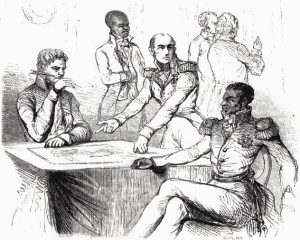To understand Haiti’s problems
one must look way back to when France owned it back in the 1800s. To resolve their political disaster, the people’s misery, and the destruction of the country’s resources, my opinion is that either France or the United States should intervene to resolve, resurrect and establish an infrastructure, promote and initiate investing from abroad in order to establish manufacturing and jobs. It is unacceptable that a country like Haiti exists at the doorsteps of the richest and most powerful country, the USA, in the 21st century!

Saint-Domingue colony
Saint-Domingue,now Haiti,was the richest and most productive European colony in the world going into the 1800s.[7][4]France acquired much of its wealth by usingslaves,with the slave population of Saint-Domingue accounting for one-third of the entireAtlantic slave trade.[8][better source needed]Between the years of 1697 and 1804,French colonists brought 800,000West Africanslaves to what was then known as Saint-Domingue to work on the vast plantations.[8][better source needed]TheSaint-Dominguepopulation reached 520,000 in 1790,and of those 425,000 were slaves.[8][better source needed]The mortality rate among slaves was high,with the French often working slaves to death and transporting more to the colony instead of providing necessities as it was cheaper.[4]At the time,goods from Haiti comprised thirty percent of French trade while its sugar represented forty percent of the Atlantic market.[4]About sixty percent of the coffee consumed in European markets was also produced in the colony.
The Haiti indemnity controversy involves an 1825 agreement between Haiti and France that included France demanding a 150 million franc indemnity to be paid by Haiti in claims over property – including Haitian slaves – that was lost through the Haitian Revolution in return for diplomatic recognition.[1] The payment was later reduced to 90 million francs in 1838, comparable to US$21 billion as of 2004)[2]
France's demand of payments in exchange for recognizing Haiti's independence
was delivered to the country by several French warships in 1825, twenty-one years after Haiti's declaration of independence in 1804.[1][3] Though France received its last indemnity payment in 1893,[4] the government of the United States funded the acquisition of Haiti's treasury in 1911 in order to receive interest payments related to the indemnity.[5] It took until 1947 – about 122 years – for Haiti to finally pay off all the associated interest to the National City Bank of New York (now Citibank).[6][5]
You may read the entire history by clicking on the button below
Recent Posts
Ulrich’s GAProductions
The Dinosaur Eye – Wall Art
Get your Wall Picture here Read More
Hot Chocolates Restaurant and Nite Club
All your Traveling needs here at Amazon Read More
My Cosmopolitan Magazine modeling Days😁
Ulrich’s Miami Mob ordeal Read More
Ulrich’s Hot Chocolates, Fort Lauderdale, Florida, 1997 – 2001
Hike to Lake Tremorgio, Ticino, Switzerland
Daniel Humm is revolutionizing 3-Star Cuisine
This is how the first vegan menu tastes in “Eleven Madison Park” in New York... Read More
Swiss Travel Soothing Music Video
Ulrich’s Guadalajara & Mexico City Experience
Chef Ulrich in Action in Guadalajara, Mexico My first visit to Mexico was with my... Read More
Chef UlrichK on Selkirk CH.13 Cooking Show
My awkward Brandy bottle pop! The video is 16 min. long – Video is 37... Read More
Ulrich in the Dominican Republic
In 1987 I arrived in Santo Domingo to work on the re-opening of the new... Read More
Ulrich’s Miami Mob ordeal
As a Swiss chef, I took the opportunity to go and see the world, that... Read More
Exciting Swiss Family Koepf Hike to 2300 m
The Bristen (3073m) is a mountain in the Canton of Uri, Central Switzerland. ... Read More
Around Monte Baldo, Italy
On my recent visit to Verona, I came across these amazing places; situated in the... Read More
Subscribe here
Click here to Subscribe Read More
Aquaria, Thermal Waters of Sirmione
The Uniquelness of our Thermal Water Click here to visit the website The... Read More
In a MOOD for Sushi?
I am not a fan of raw fish, I like my fish cooked, especially knowing... Read More